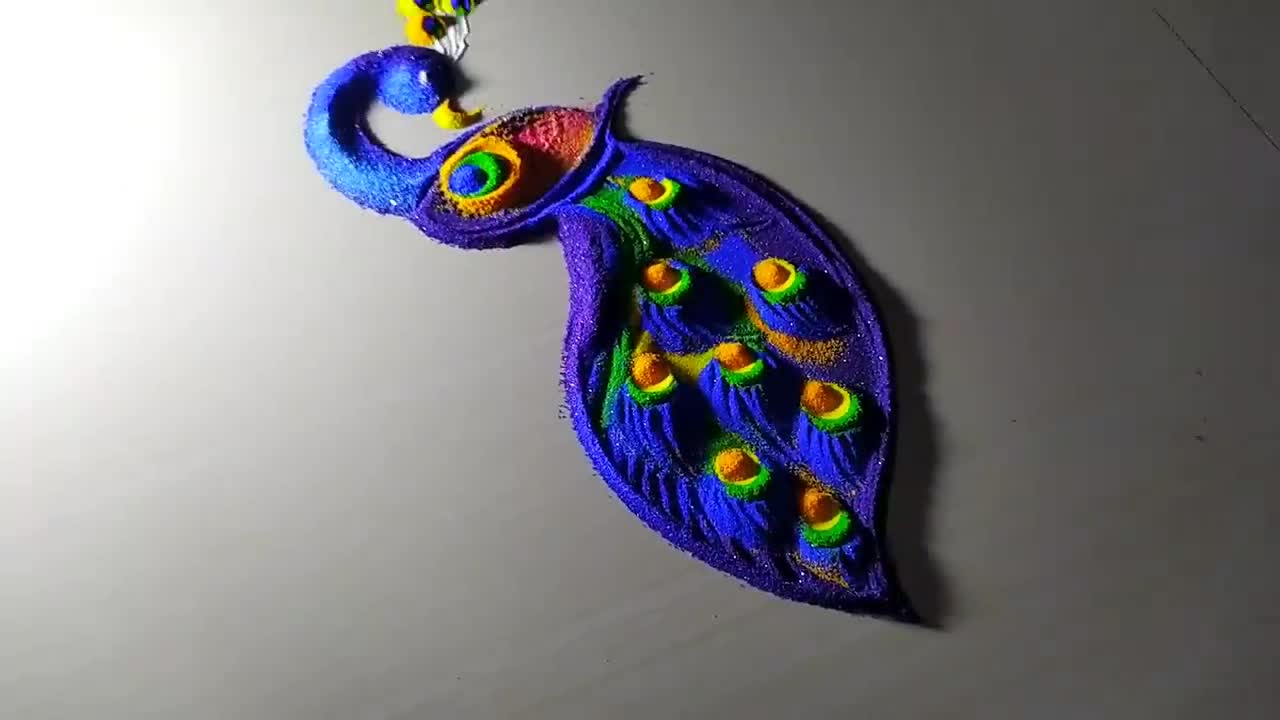Premium Only Content

Easy Peacock rangoli for Diwali using Belan_Rolling pin _ Happy diwali rangoli _ Diwali rangoli
Easy Peacock rangoli for Diwali using Belan_Rolling pin _ Happy diwali rangoli _ Diwali rangoli
Rangoli is an art form originating in the Indian subcontinent, in which patterns are created on the floor or a tabletop using materials such as powdered lime stone, red ochre, dry rice flour, coloured sand, quartz powder, flower petals, and coloured rocks. It is an everyday practice in Hindu households, however the colours are preferred during festivals and other important celebrations as it is time consuming. Rangoli are usually made during Diwali or Tihar, Onam, Pongal, Sankranthi and other Hindu festivals in the Indian subcontinent, and are most often made during Diwali. Designs are passed from one generation to the next, keeping both the art form and the tradition alive.[1]
Rangoli have different names based on the state and culture. Rangoli hold a significant role in the everyday life of a Hindu household especially historically when the flooring of houses were untiled. They are usually made outside the threshold of the main entrance, in the early mornings after cleaning the area. Traditionally, the postures needed to make a rangoli are a kind of exercise for women to straighten their spines. The rangoli represents the happiness, positivity and liveliness of a household, and is intended to welcome Lakshmi, the goddess of wealth and good luck. It is believed that a Hindu household without a clean entrance and rangoli is an abode of darida (bad luck).
The purpose of rangoli is beyond decoration. Traditionally either powdered calcite and limestone or cereal powders are used for the basic design. The limestone is capable of preventing insects from entering the household, and the cereal powders attract insects and keep them from entering the household. Using cereal powders for rangoli is also believed as panchayat booth Seva[clarification needed] because insects and other dust microbes are fed. Design depictions may vary as they reflect traditions, folklore, and practices that are unique to each area. Rangoli are traditionally made by girls or women, although men and boys create them as well. In a Hindu household, basic rangoli is an everyday practice. The usage of colours and vibrant designs are showcased during occasions such as festivals, auspicious observances, marriage celebrations and other similar milestones and gatherings.
-
 LIVE
LIVE
Phyxicx
2 hours agoRocket League with Friends! - 11/22/2024
98 watching -
 LIVE
LIVE
STARM1X16
3 hours agoFriday Night Fortnite
112 watching -
 29:51
29:51
Afshin Rattansi's Going Underground
18 hours agoJimmy Dore on Ukraine & WW3: Biden Wants a War that Trump CAN’T Stop, ONLY Hope is Putin’s Restraint
56.7K15 -
 LIVE
LIVE
Fresh and Fit
5 hours agoExposing WHO Killed JFK w/ Cory Hughes & Tommy Sotomayor
7,280 watching -
 LIVE
LIVE
RanchGirlPlays
5 hours ago🔴 Red Dead Redemption: Let's go help De Santa 🤠
226 watching -
 LIVE
LIVE
Man in America
11 hours agoWHAT?! Trump & the Fed are DISMANTLING the Global Banking Cartel!? w/ Tom Luongo
1,974 watching -
 LIVE
LIVE
HELMET FIRE
1 hour agoDEADROP IS BACK!
155 watching -
 LIVE
LIVE
I_Came_With_Fire_Podcast
6 hours agoLive Fire (No Exercise) with DAN NUNN!!!
239 watching -
 1:57:20
1:57:20
Glenn Greenwald
7 hours agoBiden's Escalation Of The War In Ukraine With Scott Horton; Lee Fang On The Junk Food Industry Sabotaging RFK Jr.'s Plans & The Gaetz Situation | SYSTEM UPDATE #371
77K73 -
 LIVE
LIVE
Toitle
1 hour agoLet's Game | TOITLE HEADS, POKE OUT | WE BE GRINDIN
152 watching